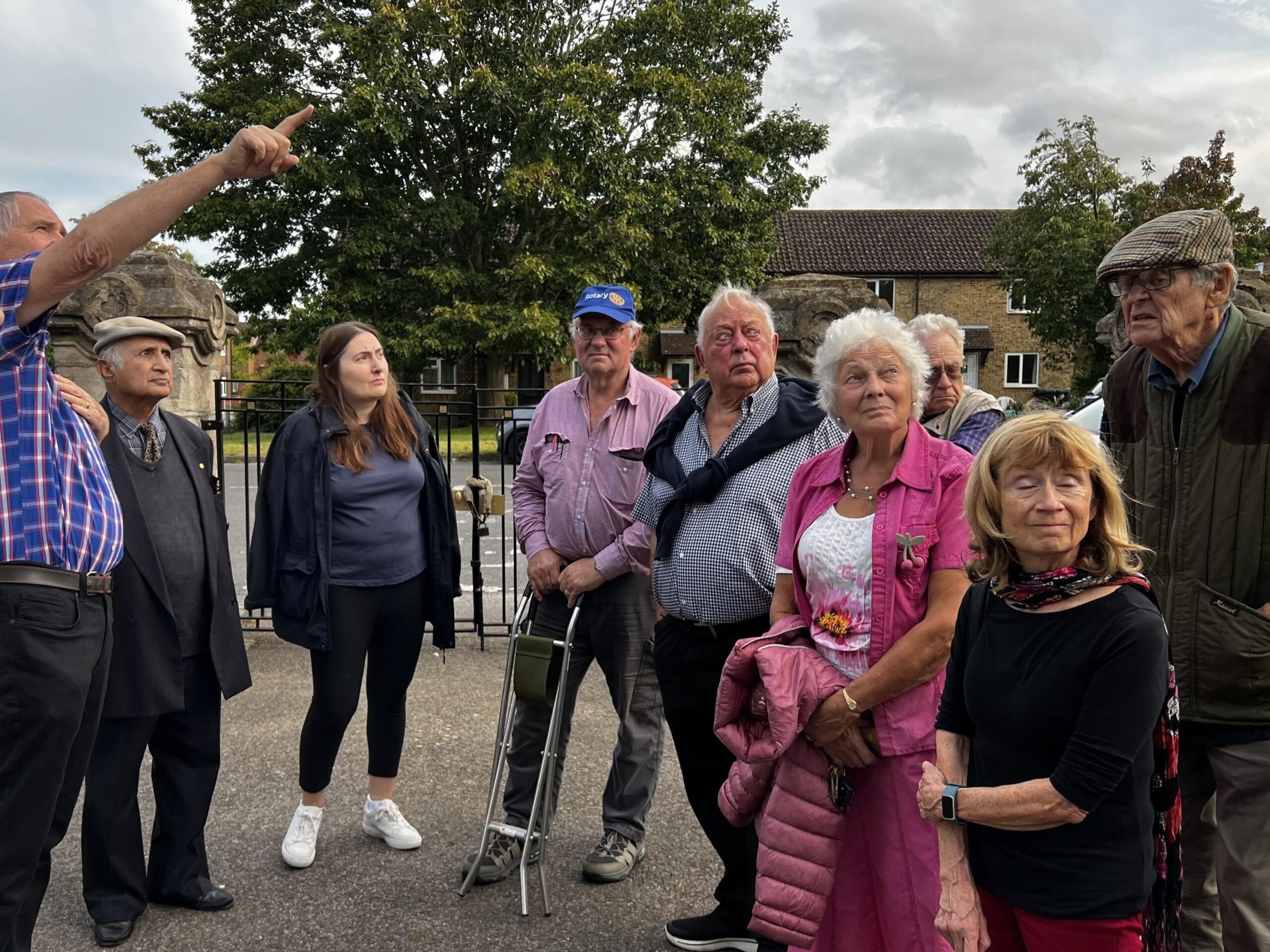
Canterbury Cemetery is a civic cemetery built originally by the Victorians in the 1870s and currently owned by Canterbury City Council. The cemetery spans around 20 acres and has a double chapel with pointed spire near its main entrance.
Around a dozen Rotarians and guests gathered at the cemetery gates at the end of September to be shown around the cemetery’s numerous trees by Tree Officer Aidan Potts. (Regular readers will be familiar with Aidan’s name from when he took some of our members and guests on a tree walk through Canterbury’s Westgate Gardens.)
It turns out that Aidan first got involved with planting trees at the cemetery some years ago, when his boss asked him if he liked trees – which he clearly does! Since then, he’s been closely involved with the cemetery’s trees and has even grown some of them himself from seed!
It was interesting to learn that although many of the trees in the cemetery have their origins in different parts of the world, most were obtained from three nurseries.
The first tree that Aidan pointed out as we walked into the cemetery was a mature Atlantic cedar which would have originated in North Africa. This tall tree, with lots of yellowish upright cones among its needle-covered branches, was grown from seedlings and is now 35 years old.
Aidan also pointed out a nearby sequoia tree (we’d previously seen one at Westgate). Next, Aidan drew our attention to a so-called “nettle tree”. Although this gets its name from its leaves, the leaves didn’t look at all like nettle leaves to us. We were interested to learn that such trees may be the “lotus” trees referred to in relation to the lotus eaters of Greek mythology. We were shown the tiny, round fruit that the tree bears; this is edible (but don’t take our word for it). The tree’s timber is quite hard and the tree itself can grow to 120 -130 ft! “So not a garden tree,” said Aidan, wryly.
Aidan then pointed out three hornbeam trees. Despite the three trees being similar, they come from different parts of the world – namely from America and China. There was also another hornbeam – an ornamental hornbeam – behind us. Sadly, that tree hasn’t been doing too well this year. We also saw a magnificent European “hop” hornbeam tree. This, we learnt, isn’t related to hops but probably got its name from its hop-like seed pods.
The next tree we saw, with smooth, greyish-brown bark, was a type of eucalyptus tree. Confusingly, it’s actually a Tasmanian mountain ash. As we could see, the tree sheds bark. This isn’t a sign of poor health as one might think. In fact, it’s a good sign; the tree shreds bark as it grows and the stem expands. Theoretically this tree can grow to 270 feet or so; it’s said that that some felled trees have been found that were around 350 feet tall! The one at the cemetery was planted around 6 years ago and was therefore much smaller. The tree produces pretty, white flowers, although there were no flowers when we were there. We learnt that some eucalyptus varieties have dormant seeds that can survive “natural” fires – although man has interrupted the normal growth patterns over the years.
Aidan then led us to one of his “favourite” trees – a small North American sassafras tree. As Aidan pointed out, the leaves of this tree are of different shapes, some simple, some lobed. We learnt that such trees were once used to make root beers in America. However, experiments on rats showed a chemical from the roots caused cancer so the roots aren’t used for root beers any longer. The leaves, however, are still used in Louisiana to thicken “gumbo” soup. It was this tree’s third year in the cemetery and it seemed to be quite happy so far – “it’s grown a few feet each year,” said Aidan. Usually the tree would be showing its vivid autumn colours by the time we visited, but as there was no sign of an autumn glow it seems that this year “autumn is a bit delayed”!
Aidan highlighted one tree in the distance that HAS just started to look autumnal – the deciduous golden rain tree, covered in yellow bunches of seed pods. This tree, which grows to about 25 ft, produces distinctive three-sided pods.
Aidan took us to another tree that was looking rather autumnal, this time with deep red leaves. ”What type of tree do you think this is?” asked Aidan as he pointed out the red, oak-leaf shaped leaves. It turns out that, despite the leaf colour, it was a type of “white” oak; all the other oaks in the cemetery are red oaks. (The two types of oak differ in the structure of “tubes” that grow up and down the trees.) White oaks can last for 15 years or so while red oaks, which are more susceptible to disease, only last about 3 years. We learnt that in the USA white oaks are far more important commercially than their red counterparts; they produce a “lovely” hard wood, although this is only really good for indoor use.
Next, we briefly looked at a tall tree behind us with large, compound leaves – the so-called “tree of heaven”. This rapidly growing tree can “go berserk”. Its fruit have a viability of about 95 %, and as a result the tree is seen as invasive and is a banned species in places such as Sardinia.
We all grouped briefly around a small rose acacia next – a tree with pretty flowers in the summer – before we moved on to see a Chinese mahogany (toona) tree. Leaves of this tree, which are also compound, can be quite large – as much as 4 ft long! We also heard about black walnut trees. These trees are also deciduous and have compound leaves; the fruit is tasty but contains a juice that can stain hands black for weeks. This particular tree, growing on a grave, was probably planted by a squirrel!
As we all passed an unknown tree, Aidan commented it was possibly a result of hybridisation. We also passed a cork tree. As we went from tree-to-tree, we learnt all sorts of things. For instance, we found out to our surprise that balsa wood is actually a hard wood – because it comes from a deciduous tree. Conversely there are types of soft woods (i.e. from conifers) that are very hard in texture! We also learnt about biological characteristics such as apical dominance and lammas growth, and about Joseph Banks, the well-known botanist.
In the distance Aidan also pointed out an oriental plane – the same species as the nobbly tree with the enormous trunk that we saw at Westgate. This one is probably one-half the age of the Westgate tree, but is showing the similar nobbly trunk.
Next, Aidan picked up something in his hands and asked us to identify the tree. Looking at the winged fruit he was holding we tentatively suggested “sycamore”– but no, we were wrong! The tree was a hornbeam maple; its fruit, curiously, looks very much like sycamore seeds!
Aidan then took us to a pine tree with “twisty” branches. This, we learnt, was a Coulters pine tree – it produces one of the biggest cones of any pine tree, each of which can weigh up to 2lbs; some cones can be up to 3 feet in length! The tree is nicknamed “widowmaker” as “these cones can knock someone right out!”
After passing a few other trees, Aidan pointed out a coast redwood (sequoia) – such redwoods are the tallest trees in the world. The one in the cemetery was described as a “baby”! These trees naturally exist in a narrow strip in California where they get much of their water from the famous Californian fog!
Aidan also pointed out a small wollemia pine; these trees are termed “living fossils” as they were known to science as fossils long before living trees were found. This particular tree type was not known until 15 years ago.
Passing by another eucalyptus which Aidan described as “well known” to him because he grew it from seed, we came to a Japanese raisin tree. This tree has some unusual biology. While most fruits form from the ovum of a flower, this tree forms “fruit” along fleshy stalks! Basically, when the flowers are pollinated the tree produces little seed capsules on stalks which get engorged and become fat, juicy and edible. Once fully ripe the fruits tastes very like raisins.
As we walked along we saw plenty of cyclamen on the ground, forming small carpets of delicate pink.
Our next stop was the “start” of the cemetery’s oak collection. This collection includes shingle oak, willow oak, blue oak, Hungarian oak, Spanish oak and Mexican oak. The latter is evergreen and the leaves are not at all “oak-y” in shape. Apparently there are no post oaks in the cemetery – trees traditionally used to make posts.
Again we came across a black walnut – described as one of the most valuable timber trees. These trees, which have large compound leaves, can get enormous.
As we passed another tree Aidan picked up a leaf – this is a “typical oak leaf”, he said. The veins are purple when the buds first open in the spring. Nearby we also saw a Japanese chestnut oak, a pontine oak and a California live oak.
The next tree that we stopped by, with trunk and branches reminding some of us of elephants, was a Chinese pistachio tree. Despite the name, the fruits of this tree are not edible. We also saw two male persimmon trees (a female was nearby, in a cage to protect it from vandalism).
The last three trees we saw in the cemetery were a chequers tree (a tree that produces edible fruit that need to be “bletted” before eating) a cucumber magnolia tree (so-called because of the shape of its fruit) and an autumn blaze acer (which should bring rich colour to the cemetery as the seasons change).
“That’s about it really,” said Aidan as we reached the end of his enlightening talk. He was thanked on our behalf by President Rosemary Doyle before several members of the groups headed off to the nearby Victoria hotel for a meal and a chat about trees!
Picture: Aidan points some trees out to us during our tour. Picture credit: Rotary Club of Canterbury.
For further images, please visit the album on our Facebook page.


